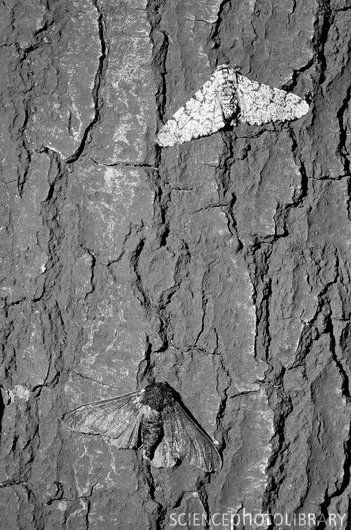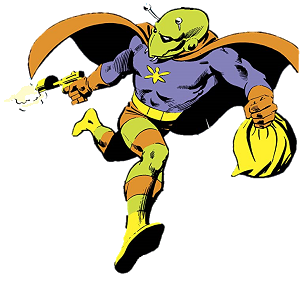
special interest in moths so this is my infodump station | i do IDs!! | sideblog is @oinglboingl | credits to Olivier Bouteleux for the avatar and @campesine-moved for the header | sideblog is @oinglboingl
263 posts
Natural Selection And The Case Of The Peppered Moth
Natural Selection and the Case of the Peppered Moth
If you're anything like me and you spend a lot of time talking about Interesting Facts and Things to anyone who will listen, you may have heard a slightly warped account of the story of the peppered moth. Maybe someone said something like: "Oh yeah and in England there was this moth that turned black during the industrial revolution due to all the coal dust in the air". Which is... not exactly true.

Let me start the story from the beginning. Before the industrial revolution, peppered moths (Biston betularia) were distributed across England, Europe and North America. They existed in 3 morphs: typica (mostly white), carbonaria (mostly black) and insularia (inbetween). Note: I'm mainly going to talk about the typica and the carbonaria morph here.
Before the industrial revolution, the typica morph was the predominant morph. Peppered moths lived in forests filled with light trees and lots of lichen, a good place for a typica morph to blend in. The carbonaria morphs were living life on hard mode, though. They did not blend in, and were more easily picked out by predators like birds. Below you can see how well a typica morph blends into lichen.

Then the fire nation attacked. Jk, then came the industrial revolution. Factories were pumping out coal fumes into the air, covering forests nearby with coal dust and killing the lichen that grew on them. In these forests, the carbonaria morph blended in better. Predators began to pick out typica morphs more often. And so, carbonaria morphs became the predominant morph in forests near industrialized areas.

Naturalists, noticing this, wanted an adequate answer on why this was happening. In the 1950s Bernard Davis Kettlewell used various methods to test the hypothesis that it was natural selection. And indeed it was. Typica morphs were 2x more likely to be eaten in a polluted forest than carbonaria morphs, and vice versa.
This phenomenon was so common, and observed in many other moth species across industrialized areas, that it was even given a name: industrial melanism.
So there you go. The full story of the peppered moth :)
Oh and I should add that in areas where the effects of industrialization were reversed, the typica morph once again becomes more common.
Sources:
Peppered moths: moth life cycle
Peppered moths: natural selection
Peppered moths: dr ketllewell
-
 crookeddiscwizard liked this · 1 year ago
crookeddiscwizard liked this · 1 year ago -
 averyreaderofmanybooks liked this · 1 year ago
averyreaderofmanybooks liked this · 1 year ago -
 flyingbooks42 reblogged this · 1 year ago
flyingbooks42 reblogged this · 1 year ago -
 flyingbooks42 liked this · 1 year ago
flyingbooks42 liked this · 1 year ago -
 maybe-maidens-fanblog reblogged this · 1 year ago
maybe-maidens-fanblog reblogged this · 1 year ago -
 maybe-maidens-fanblog liked this · 1 year ago
maybe-maidens-fanblog liked this · 1 year ago -
 lights-at-night reblogged this · 1 year ago
lights-at-night reblogged this · 1 year ago
More Posts from Mysticmothworld
Hey whats up my darlinks (read in old russian woman voice) I've been editing my old posts for clarity and also, in the case of this particular post, for misinformation. Not to worry, the whole thing isn't bs but I simply changed the largest saturniid moth from the hercules moth to the atlas moth, and adjusted the wingspan of the atlas moth to reflect that. As they say on this hellsite: "you are not immune to propaganda" so yeah my silly goofy ass may have believed a source I shouldn't have.
(also tomorrow I'm adding image sources where i left them out)
Saturniid Moths
(aka those moths with the eyes)

Moths from the Saturniidae family are probably the most well known moth species around. This family has approximately 1500 species distributed worldwide, although they're more common in tropical areas. They have these fake eyes that they don't display when at rest, but when disturbed, they flap their wings, displaying eyes made to mimic owl or snake eyes, and that gives them enough time to escape their predators. These eyes are easily their most recognizable feature. They also have very large wings, the largest saturniid has a wingspan of up to 30 cm (but we'll talk about that later). They are mostly nocturnal, and easily attracted to light, although some are diurnal. Adults cannot eat because their mouthparts don't function. In some places, their caterpillars (like the mopane worm) are eaten.
Check out this interesting diagram of Saturniidae moth sizes in Indiana. It should give a general idea of how big most Saturniidae are.

Some iconic saturniids include:
The Io moth (Automeris io)

These guys are sexually dimorphic, the male is the yellow one the female is the brown one above it. They have unusually large eyespots even for saturniids. They are distributed across Canada, the US and Mexico.
The Luna moth (Actias luna)

Pictured here is a male luna moth, luna moths are sexually dimorphic and the females look similar although more triangular in shape. Fun fact: the 'tails' on their wings are there to help reduce predation as bats will chomp on them instead of, for example, a main part of their wing which may prevent them from flying and/or enable the bat to have better grip on them and just eat them. Distributed across the US and Canada.
The Atlas moth (Attacus atlas)

As you can see, these guys are pretty big. Their wingspan can be up to 30 cm wide. Fun fact: their cocoons are so strong they are sometimes used as purses. Distributed across China, India, Malaysia and Indonesia.
Hercules moth (Coscinocera hercules)

VERY VERY BIG. The females have the biggest wing surface area (300 square cm) of all extant insects. They have a rather large wingspan as well, around 27 cm. The caterpillars can sometimes take more than a year to metamorphose. Native to Northern Australia and New Guinea.
Sources:
Saturniid moth
Family saturniidae
Cool study on moth diversity in Mexico
Io moth
Luna moth
Largest moth
Spotlight: the atlas moth
Hercules moth
Moths with larger hindwings and longer tails are best at deflecting bats (very interesting read)
Moths?
Moths? Moths. Moths moths moths :)









Reminder that one of the og moth ocs was killer moth, a flamboyant batman villain who saw an article about batman in prison and decided to become his nemesis (if that isn't a little fruity idk what is). Also he had a mothmobile with antennae on the front and a cocoon gun which he used to wrap up his enemies



Top tier character design tbh.
Image sources: wikipedia and DC database
there's an end in friend.
there's an over in lover.
there's hell in hello.
there's a lie in believe.
but father and mother?
that's where you find fa(THE)r (MOTH)er.
